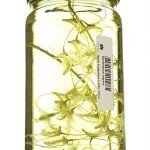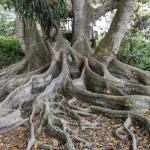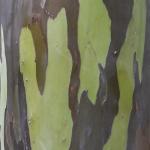 Plant science and conservation have been important activities at the Marie Selby Botanical Gardens since its founding in 1973. The Botany Department specializes in plant inventory and classification, which is the basic information needed to understand and conserve plant diversity. Staff scientists address the questions, “What are plants called, where do they grow in nature, and how are they related?” Answers involve studies of plant distribution, morphology, molecular systematics, and ecology through research in the field, in the greenhouse, and in the laboratory. Staff botanists, associates, and volunteers work as a team to advance conservation projects at local, regional, national, and international levels.
Plant science and conservation have been important activities at the Marie Selby Botanical Gardens since its founding in 1973. The Botany Department specializes in plant inventory and classification, which is the basic information needed to understand and conserve plant diversity. Staff scientists address the questions, “What are plants called, where do they grow in nature, and how are they related?” Answers involve studies of plant distribution, morphology, molecular systematics, and ecology through research in the field, in the greenhouse, and in the laboratory. Staff botanists, associates, and volunteers work as a team to advance conservation projects at local, regional, national, and international levels.
The Selby Gardens Botany Department is the headquarters of the Mulford B. Foster Bromeliad Research Center (BRC), the Gesneriad Research Center (GRC) and the Orchid Research Centers, (ORC), as well as the Herbarium, Molecular Studies Lab, Spirit Lab, Research Library, and the staff and volunteers offices. The Gardens’ collections include extensive living and preserved plants, photographs, and literature, providing a rich environment for conducting botanical research.
View Selby Gardens’ Plant Collection Policy and Procedures HERE
Facts & Figures
- Hundreds of expeditions into the tropics and subtropics by Selby Gardens botanists have contributed to the most diverse living and preserved collection of epiphytes in the world.
- The Selby Gardens living collection numbers 13,500 plant accessions in 214 families.
- The Herbarium (SEL) has more than 115,000 dried specimens, with 2000 taxonomic types (the actual plant used in naming a new species). The Spirit Collection has more than 36,000 preserved orchid, gesneriad, and bromeliad flowers.
- The Research Library houses 7,000 books, including a rare book collection of 500 volumes, rare print collection of 2,500 prints dating to more than 100 years, and several hundred active periodicals, along with engravings, slides, videotapes, and microfiche files.
- Selby Gardens’botanists have discovered and/or described some 2,000 plant species new to science.
- Selbyana, a peer reviewed journal, published since 1975, publishes original research on tropical plants with emphasis on epiphytic plant families.
- Volunteers and research interns work with staff on tasks that range from pressing, labeling, and scanning plant specimens to identifying plants, conducting fieldwork, proofing publications, and assisting with collections and library management.
About Botany
A team of dedicated individuals provide the scientific and curatorial expertise essential in maintaining the Gardens as a first class botanical institution.
Adjunct Staff
To broaden and strengthen the publication base and research efforts of the Gardens, a number of scientists are appointed as Senior Scientists, Research Associates, and Editorial Board members for a limited period of time. They serve by reviewing articles and research proposals, providing scientific expertise, offering occasional seminars at the Gardens, and collaborating with the Gardens’ staff on research projects.
Interns
The Garden’s intern program provides critical, real-world experiences for pre- and post-doctoral students and professionals from around the world.
Volunteers
More than 40 volunteers play a key role in assisting with the Department’s functions, particularly in the areas of specimen preparation, imaging, and documentation.
Acknowledgements
We wish to acknowledge the tremendous help given to us by our many individual supporters. Their hard work, financial contributions, and devotion to our mission are remarkable, and our collections, projects, and publications are better as a result. Thank you friends, we couldn’t do it without you!
Thank You!
Selby Gardens thanks the following foundations and agencies for their financial support:
- Cactus and Succulent Society of America
- Frank E. Duckwall Foundation
- Harry Sudakoff Foundation
- Institute of Museum and Library Service
- National Geographic Society
- National Science Foundation
- Florida Native Plant Society
- The Bromeliad Society International
- The Gesneriad Society
- United States Fish and Wildlife Service
Editorial Board
The Editorial Board is comprised of respected scientists who embody the diversity of Selby’s mission and who help review articles submitted to Selbyana and provides guidance on editorial matters. Board members must be able to evaluate and return manuscripts with constructive comments in a timely fashion. To ensure that the Board continually suits the needs of the journal, the editor of Selbyana examines its membership regularly, along with the Executive Director and the scientific staff. Tenure on the board is usually three years, renewable by invitation by the Gardens or by approved request from the member.
- David Benzing, Marie Selby Botanical Gardens, Sarasota, Florida
- Antonio Toscano de Brito, Marie Selby Botanical Gardens, Sarasota, Florida
- Gregory Brown, University of Wyoming, Laramie, Wyoming
- Sally Chambers, Marie Selby Botanical Gardens, Sarasota, Florida
- Bruce K. Holst, Editor, Marie Selby Botanical Gardens, Sarasota, Florida
- Helen Kennedy, University of British Columbia, Vancouver, British Columbia
-
Brad Oberle, New College of Florida, Sarasota, Florida
- Larry Skog, National Museum of Natural History, Smithsonian Institution, Washington, D.C., retired
Research Associates
Research Associates expand Selby’s publication base and research effort. They are respected scientists who are currently collaborating with Selby on a common research interest.
- Tatiana Arias, Colombia
- Julio Betancur, Universidad de Colombia, Bogotá, Colombia
- Gregory K. Brown, University of Wyoming, Laramie, Wyoming
- Sally M. Chambers, Eastern Kentucky University, Richmond, Kentucky
- William Cinea, Jardin Botanique des Cayes, Les Cayes, Haiti
- Laura Clavijo, Universidad de Colombia, Bogotá, Colombia
- Lou Jost, Tungurahua, Ecuador
- Elton Leme, Herbarium Bradeanum, Rio de Janeiro, Brazil
- Brad Oberle, New York Botanical Garden
- Franco Pupulin, Jardín Botánico Lankester, Universidad de Costa Rica, Cartago, Costa Rica
- Brian Sidoti, National Tropical Botanical Garden, The Kampong, Florida
- Larry Skog, National Museum of Natural History, Smithsonian Institution, Washington, D.C., retired
- Antonio Toscano de Brito, USA
Explore Selby’s Botany Department




